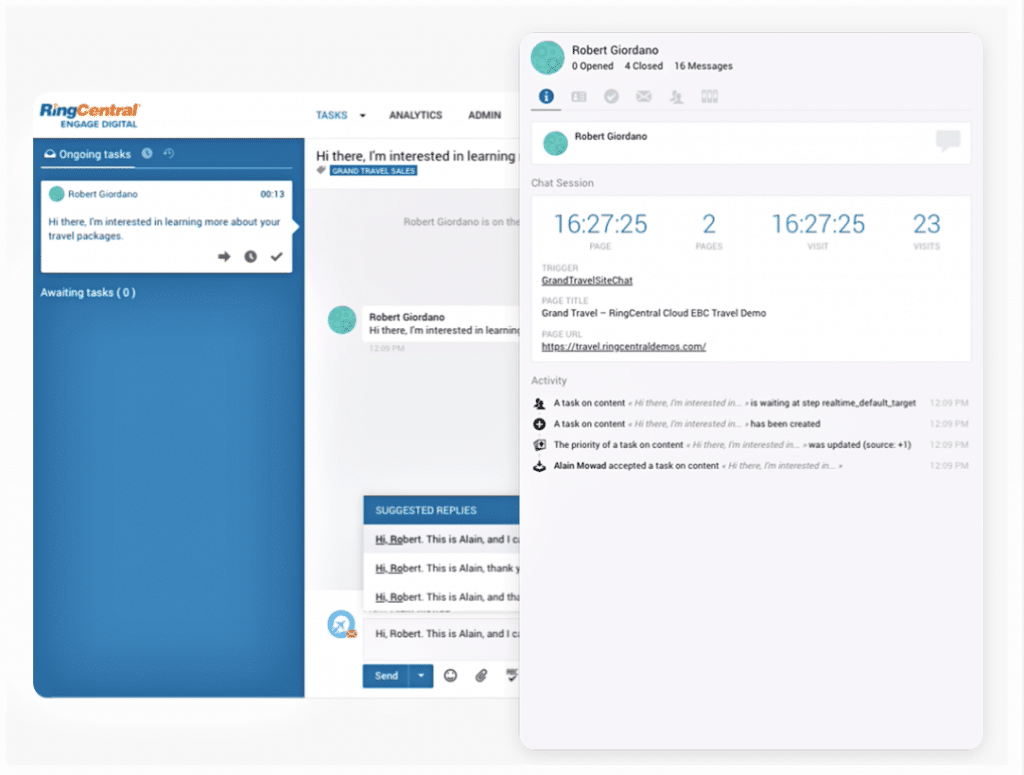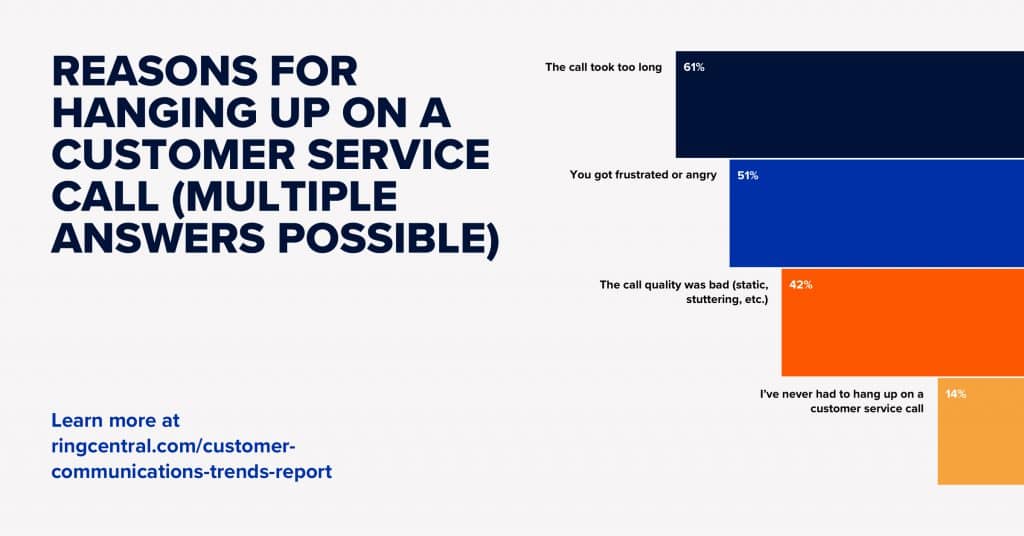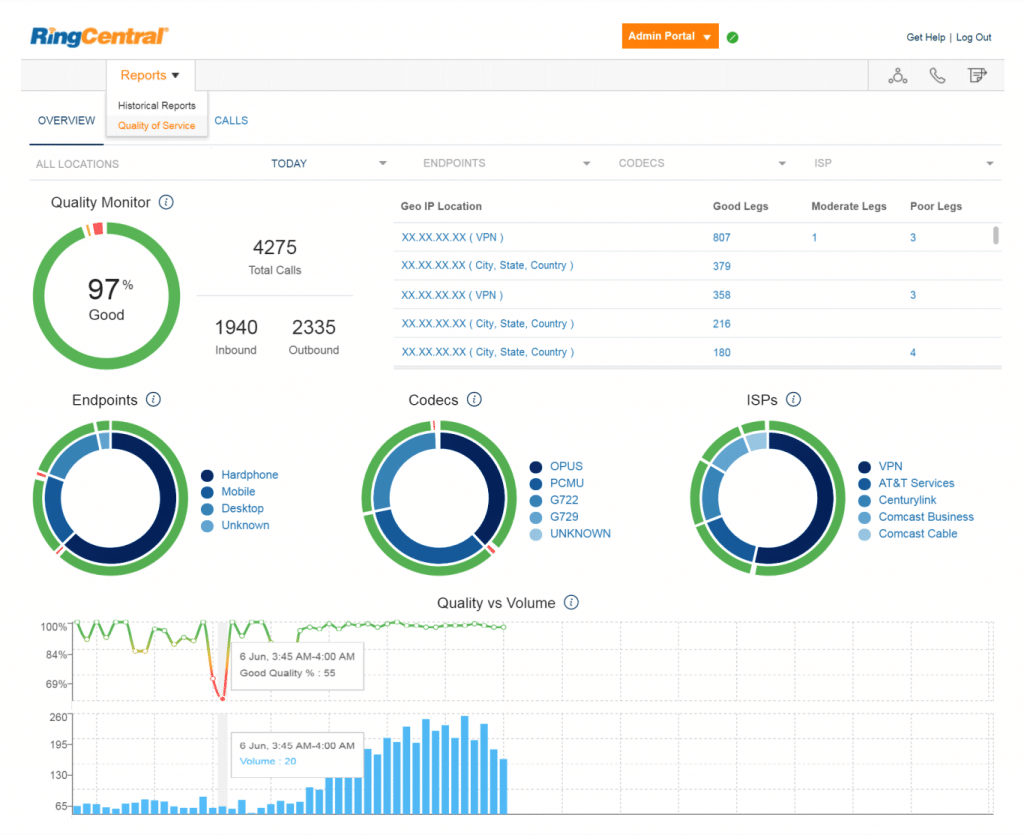Even if the term “inbound calling” doesn’t ring a bell (pun intended), you’ve no doubt interacted with this common business practice on numerous occasions. Like, for example, when your two-year phone contract finally comes to an end, so you contact your cell service provider to discuss renewal terms (like which of your children you must sacrifice in order to get your hands on the new iPhone free of charge).
In other words, inbound calling is when customers or prospects initiate contact with your business. And because you don’t know what the customer or prospect needs until you talk to them, this type of support is often referred to as reactive support: they call, you react.
Inbound calls are generally handled by a call center (aka contact center) or help desk—although this isn’t always the case with smaller companies or regional branches that may have only one or two people fielding all calls (think Kelly Kapoor from The Office). And the importance of having a good inbound calling strategy should definitely not be underestimated. It can affect anything from how quickly your team can pick up the phone, to how quickly they can resolve your customers actual problems:
Types of inbound calls include those for tech support, sales inquiries, complaints, contract renewals, billing, and more. Oh, and inbound calls don’t always have to be “calls” either—as in on the telephone—inbound calls can also include inquiries via live chat, email, and even social media.
If you’re thinking about your inbound calling strategy (or lack thereof), look no further. In this post, we’ll look at:
- The difference between inbound and outbound calling
- How to handle inbound calls
- The benefits of having a call center or contact center
- The pros and cons of outsourcing inbound calling
- What to do if your business doesn’t need a call center (yet)
- 5 tips to strengthen your inbound call strategy
How customer-obsessed is your business? Take the quiz to find out how to improve your customer experience.
But what about outbound calling?
In contrast, outbound calling is when you initiate a call with your customer or prospect, like in response to a support request, to let a customer know about a new service, or to collect survey data. This type of calling is considered proactive since it allows you to prepare for the call.
Have you ever called a company and been given the option to request a “callback” versus staying on the line for ages, listening to awful elevator music? That callback is an outbound call.
Another common use of outbound calling is cold sales calling, where sales reps reach out to leads who may (or may not) have indicated they’re interested in your offer.
Put simply, the key difference between inbound and outbound calling is who initiates the call—does it come from outside the organization (inbound) or inside the organization (outbound)?
How should you handle inbound calls?
Handling inbound calls might seem like a simple concept—you get a call, you answer it—but any customer-centric company knows that there’s an art and science to handling inbound calls to best serve your customer (and your business).
To demonstrate the importance of a solid inbound call strategy, consider this scenario:
A customer bought something from you, and it’s either not working as intended or it’s straight up broken. Needless to say, they’re frustrated, so they dig through the product manual or do some Googling and finally find a toll-free customer service number. When they dial it, they get an automated system (not surprising), but when none of the options sounds like what they need, they press “0.” They’re disconnected. Now they’re mad. They try the number again and choose the first option. A customer service rep answers but says unfortunately what they need is handled by another department, so they’re transferred. Once again, they’re disconnected for some reason. Irate, they start Tweeting at your company, ripping your customer support. They post on Facebook, warning their network to steer clear of your brand—not the kind of brand awareness you were looking for. They never, ever purchase another thing from your company. Ever.
Did you find yourself cringing as you read the above scenario? It’s an extreme example of what poor inbound call handling can look like, no doubt, but it absolutely highlights why inbound call handling should be a top priority, not an afterthought, for businesses both big and small.
Many hands make light work with inbound call centers
Even if you’re managing a small business that has no immediate use for a full-on call center (totally cool if you are—everyone has to start somewhere!), you could still start planning for a call center or a phone help desk to field inbound calls. If you’re going to grow, then people will come calling. It’s inevitable, and it’s a good thing.
Inbound call centers are the brain of your organization, taking in all the external stimuli, organizing it, and distributing it to the appropriate business “limb.” When inbound calls are received, they’re processed and sorted—often via an interactive voice response (IVR) system—and then either handled directly by call center representatives or transferred to the assigned department.
💡 Pro-tip:
Even if a contact center doesn’t make sense for your small business (yet), installing an IVR and/or call routing system can ensure the caller is transferred to the right person or department without having to go through reception.
Just a few years ago, inbound call centers were centralized, with all representatives usually in the same (big) room. But now, thanks to technology, call center teams can be distributed across multiple locations and time zones. So long as reps have access to a stable internet connection, they can use online tools to communicate with customers via their preferred channels (including voice, live chat, SMS, social, messaging apps, and email) from anywhere in the world:
A few more perks of having an inbound call center:
- You’re able to rely upon a dedicated team trained in resolving issues, answering questions, and relaying information efficiently (and hopefully pleasantly).
- In addition to solving problems and answering questions, call center reps can also stand-in as pseudo sales reps by upselling existing customers—after all, they should be just as familiar with the benefits of your products or services.
- They might be able to dissuade customers from cancelling your services or returning your product.
- You can handle more volume more efficiently, which is particularly important during seasonal upticks or new product/service launches.
- Your business would be available all hours of the day and night, since you can hire agents in different timezones.
🕹️ Get a hands-on look at how RingCentral can reduce your inbound calls and help your team provide customer service more efficiently by booking a product tour:
💰 You can also use this calculator to see roughly how much your business could save by using RingCentral to support your team’s communication with each other, clients, freelancers, and more.
To outsource or not to outsource your inbound calling…
That is the question, isn’t it?
Keeping your call center in-house gives you better quality control because the team is fully integrated into your company. An added benefit of having an integrated call center is you’re that much closer to the people who pay your bills: the customers. The value of their feedback—both positive and negative—cannot be overstated. Make sure you have a system in place for call center reps to document and categorize feedback so you can easily sort through it when it comes time for tweaking existing offers or developing new ones.
Of course, if you do decide to outsource, the biggest benefit of that (also called business process outsourcing, or BPO) is cash savings. Beyond that, outsourcing frees you up from having to accommodate changes in call volume and staffing since that’s generally handled by your contractor.
Whether you go in-house or the BPO route, remember that neither is better nor worse—it’s just about what makes most sense for your business. That said, don’t take this decision lightly: make sure you do your homework and, at the very least, chat with other business owners who’ve been in your position to help identify potential pros and cons.
What if an inbound call center doesn’t make sense for you? (4 questions to ask)
As mentioned, setting up an inbound call center might not make sense for everyone. That’s okay. But just to gut-check if that’s the case, ask yourself these four questions:
- Am I able to respond to customer inquiries promptly and efficiently?
- Am I confident that my callers aren’t waiting on hold for unreasonable amounts of time? (For reference, a recent survey found nearly two-thirds of respondents wouldn’t wait on hold longer than two minutes.)
- Am I available during the hours and days when most customers or prospects are trying to contact me?
- Are my customers satisfied with the service I’m providing? (If your answer is “I don’t know,” it’s probably time to send out a survey)?
If you answered yes to most of the questions above, you probably don’t need a call center just yet.
But even so, if you’re planning on growing your business, it doesn’t hurt to start planning for a call center (or some kind of inbound calling solution) in the future. This will ensure you’re not making snap decisions when your company has a sudden influx of inbound calls.
5 ways to strengthen your inbound call strategy
Whether you already have an inbound call strategy or you’re in the process of developing one to handle all the calls and emails you’re getting, the following tips will—in the words of Daft Punk—make it better, faster, stronger. Which is a key if you want to provide a good overall customer experience.
-
Use inbound calling technology
The right technology will enable your team (of one or 100) to help more inbound callers, in less time, with less effort—and still deliver delightful service. Consider implementing a call routing tool to direct the caller to the right person along with important caller information like location, purchase history, plan details, and more.
And don’t forget to think about the tools you’re already using and how they might interact with your inbound call strategy. For example, some call center tools can integrate with your customer relationship management (CRM) tool, so that you can, at a glance, see your customer’s full relationship history with your business, allowing you to provide the most personalized call experience:

For example, with RingCentral’s Zendesk integration, your incoming calls are automatically synced with matching customer records (if it’s a customer calling).
-
Invest in intensive customer service training
Customer service has a reputation for being an entry-level job, which is often confused with being an “easy” job. And as anyone who’s worked in customer service knows… that’s not true.
In fact, customer service skills should be developed over time with continuous training. Reps not only need to retain and relay vast amounts of information, they also need to be proficient multitaskers, clear communicators, and excellent problem-solvers.
Beyond that, they need to know how to empathize with your customer—to put themselves in their shoes to better understand the problem and to deliver a solution that will make the customer happy. Remember, customer service reps interact with your customers more than anyone else in your business would so it’s important they have the training and support to represent you well.
-
Diversify your inbound “call” channels
Although over-the-phone service remains a key support channel, it’s also the most expensive since you can only help one person at a time. To lower this cost, divert some of that phone traffic to other more efficient channels, like live chat—and if you really want to be budget-conscious, there are tools out there that take care of live chat along with phone calls and other communication channels.
For instance, RingCentral’s live chat tool shows you who’s chatting with you, which comes in handy if it’s a customer who already has a relationship with your business (see it in action by booking a quick demo here):

While the average person can only take one phone call at a time, they can often take on two, three, or more live chats at once. Email, too, is far “lower touch” (meaning a low level of personal contact with customers), especially since you can save even more time by using templated responses to answer common customer questions.
-
Help customers help themselves
By investing in “self-serve” methods of support, like a good FAQ page and easy-to-follow instructional resources, you empower customers and prospects to answer their own questions rather than reaching out to you—which saves everyone time.
Sure, you’ll always have some folks who prefer hand-holding, but for those people who hate contacting customer support, why not give them a hassle-free way to resolve their own problems?
Pro-tip:This is by no means a top priority for every business, but if you find that you’re spending a lot of time answering the same few questions, that’s a sign that you should look into making an FAQ page for your website.
-
Track everything, always
Consider the question, “Are your customers satisfied with the service you’re providing?”
If you answered “I don’t know,” that’s a pretty good indication that you should be setting up some kind of tracking method to help you answer this confidently, one way or the other. Just a few of the call center metrics you should be tracking include:
- Call abandonment rate: percentage of callers who hang up before they speak to someone
- Time on hold/in queue: average time a caller waits before speaking to someone
- Time to resolution: average time it takes for you to resolve an issue
- First-call resolution: percentage of calls that are resolved after the first interaction
- Customer satisfaction: NPS is a great way to measure this
Oh, and make sure whatever inbound calling tool you’re using has a way of measuring at least some of these metrics for you:
What’s your inbound calling strategy?
If you’re scrambling to amp up (or just create) an inbound calling strategy, don’t worry—it might be a good thing. After all, an influx of inbound calls could indicate more customers coming in, which means more growth.
Of course, with growth comes more work, and it can be tempting to put inbound calling on the backburner while you focus on seemingly more important tasks. Try not to do this.
The way you respond to a customer or prospect who’s reaching out to you could make or break their relationship with your brand. Only by establishing a solid inbound calling strategy can you be sure that your customers and prospects are properly taken care of. Plus, this lets you focus your attention and energy on growing your business and acquiring new customers.
Originally published Jan 01, 2021, updated Jul 24, 2024







